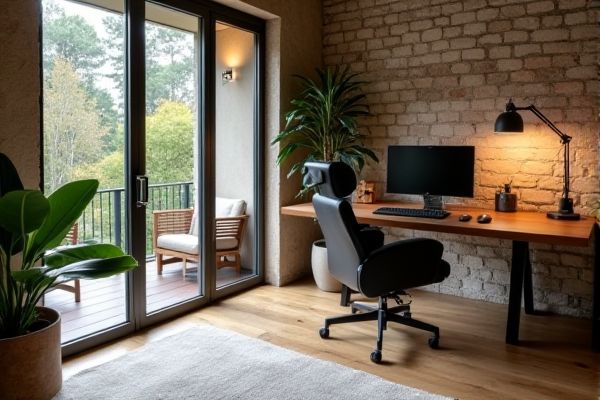
Ergonomic desks and standing desks in basements offer unique benefits for improving posture and reducing discomfort during work, with ergonomic desks focusing on adjustable features to support your body alignment, while standing desks encourage movement and reduce sedentary time. Explore the rest of the article to discover which option suits your basement workspace needs best.
Table of Comparison
| Feature | Ergonomic Desk | Standing Desk Basement |
|---|---|---|
| Design Purpose | Promotes posture and reduces strain while seated | Encourages standing work with basement space utilization |
| Adjustability | Ergonomic chairs and desk height adjustments | Fixed or adjustable height standing surface |
| Health Benefits | Reduces back, neck, and wrist pain | Improves circulation and reduces sedentary behavior |
| Space Utilization | Standard office or home use | Optimized for basement areas, saving upper floor space |
| Typical Users | Office workers seeking comfort and posture support | Users needing active workstations in basement environments |
| Cost Range | $150 - $600 depending on features | $200 - $700 depending on customization |
Introduction to Ergonomic Desks and Standing Desks
Ergonomic desks are designed to support proper posture and reduce strain by allowing adjustments in height, angle, and workspace layout, promoting comfort during prolonged use. Standing desks, often featured in basements or home offices, encourage alternating between sitting and standing, which can improve circulation and reduce sedentary behavior. Choosing the right desk for your basement setup enhances productivity and supports your physical health throughout the workday.
Key Features of Ergonomic Desks
Ergonomic desks feature adjustable height settings, customizable angles, and integrated cable management to promote healthy posture and reduce strain during long work hours. These desks often include wrist rests, monitor stands, and spacious work surfaces designed to enhance comfort and productivity. Your workspace benefits from ergonomic desks by minimizing musculoskeletal issues compared to traditional or standing desks installed in basements.
Benefits of Standing Desks in a Basement Setting
Standing desks in a basement setting promote better posture and reduce the health risks associated with prolonged sitting, such as back pain and poor circulation. These desks improve energy levels and focus by encouraging movement and reducing feelings of fatigue that often occur in enclosed basement spaces. Your basement workspace can become more dynamic and comfortable with the integration of an ergonomic standing desk, tailored to support both standing and sitting positions for optimal productivity.
Comparing Ergonomic and Standing Desks for Home Offices
Ergonomic desks in home offices prioritize adjustable features such as tiltable surfaces, customizable heights, and wrist support to reduce strain during prolonged work sessions. Standing desks emphasize promoting movement and reducing sedentary behavior by allowing users to alternate between sitting and standing positions, with some models featuring electric height adjustments for convenience. Both options aim to enhance productivity and comfort, but ergonomic desks focus more on personalized posture support, while standing desks encourage active work habits.
Health Impacts: Sitting vs. Standing Workstations
Ergonomic desks in basement setups promote proper posture and reduce strain, minimizing risks of musculoskeletal disorders linked to prolonged sitting. Standing desks encourage movement and improve circulation, helping to decrease the dangers of sedentary behavior like cardiovascular issues and poor metabolism. Choosing the right workstation balances comfort and health, allowing your body to alternate between sitting and standing for optimal wellness.
Space Optimization for Basements with Desk Choices
Ergonomic desks designed for basements often feature compact dimensions and adjustable components that maximize limited space without sacrificing comfort or functionality. Standing desks with slim profiles and integrated storage options optimize basement area by reducing clutter and allowing flexible positioning against walls or corners. Selecting a desk with modular features enhances spatial efficiency, making it easier to maintain an organized and productive basement workspace.
Design Considerations for Basement Workspaces
Basement workspaces require ergonomic desks designed with adjustable height and compact footprints to maximize limited space while ensuring comfort. Standing desks for basements should feature sturdy frames and moisture-resistant materials to withstand potential dampness and uneven floors. Your choice must balance flexibility and durability to support healthy posture and productivity in challenging basement environments.
Cost Comparison: Ergonomic vs. Standing Desks
Ergonomic desks typically cost between $200 and $600, offering adjustable features that promote comfort during extended sitting periods, while standing desks range from $300 to $1,200, depending on electric adjustments and build quality. Standing desks often require extra investment for accessories like anti-fatigue mats or monitor arms, increasing your total setup cost. Considering your budget and desired functionality helps determine whether an ergonomic or standing desk basement solution best meets your workspace needs.
Tips for Choosing the Right Desk for Your Basement
Selecting the right desk for a basement workspace requires considering ergonomic features that promote comfort and reduce strain during extended use. Opt for adjustable height desks that transition between sitting and standing to accommodate varying postures and improve circulation in often cooler, confined basement environments. Prioritize desks with sturdy, moisture-resistant materials and ample storage to optimize limited space and maintain organization in typically lower-light, humid basement areas.
Conclusion: Which Desk is Best for Your Basement Workspace?
Choosing between an ergonomic desk and a standing desk for your basement workspace depends on your specific needs for comfort, posture support, and space utilization. Ergonomic desks offer adjustable features that cater to prolonged sitting with optimal spinal alignment, while standing desks promote movement and reduce sedentary time, which can be beneficial in lower light and cooler basement environments. Assess your typical work activities, basement layout, and health goals to determine which desk enhances productivity and well-being in your unique space.
 homyna.com
homyna.com